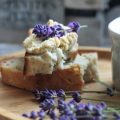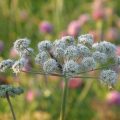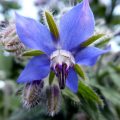- The Miraculous Shiny Bush Plant - January 18, 2021
- Colorful, Edible and Medicinal Celosia - January 10, 2021
- Radish, a Nutritional Power House - December 19, 2020
Agastache foeniculum or anise hyssop is a perennial herbaceous plant that is a member of the mint family. It is self-seeding and can also propagate by rhizomes. The herb has a scalloped edge, catnip-like leaves, and small lavender-blue flowers. It is often grown for medicinal, ornamental and culinary purposes. In Canada and America, natives were fond of eating anise hyssop as dessert while the Cheyenne used anise hyssop tea for managing colds and coughs.
Anise hyssop flowers emit a strong aroma that closely resembles a mix of mint and licorice. While most flowers have a sweet fragrance but taste bitter, anise hyssop flowers are surprisingly sweet. In addition, the flowers retain their smell and color even when dried.
Nutritional value
Both the leaves and flowers of the plant can be eaten raw or cooked. The essential oil derived from anise hyssop features antibacterial, antiviral and anti-inflammatory compounds. The oil contains limonene, a component that is known to promote the health of the digestive tract and neutralizes the acid. The oil also contains methyl chavicol, a compound used to flavor perfumes and liquors.
Anise hyssop flowers have a lighter flavor compared to leaves and make for beautiful garnishes or additions to salads. If you are looking for perfect garnishes for tea parties, look no further than these flowers.
Anise tea/infusion
Anise hyssop flowers and leaves make delicious, black, flavored tea that is ideal for treating cold and flu. To make anise hyssop tea, steep fresh flowers in hot water, strain and serve.
Anise cordial
Anise hyssop is a well-known traditional ingredient for making delicious homemade infusions. To make the cordial, fill a jar half-way with fresh leaves and fill the rest of the jar with vodka. Let the mixture sit for about a month. Strain the leaves and sweeten the drink with sugar syrup. Congratulations! You just made anise-flavored dessert cordial.
Anise hyssop flowers’ sweetness makes them ideal in desserts as they do not need to be sweetened with artificial sugars. In addition, the flowers can be pureed into jam and jelly mixes.
According to Scott and Rachelle Vivian of Beast restaurant, Toronto, anise hyssop can be used to make ice cream. “It’s really nice, beautiful, floral, and then you get that anise flavor, that licorice flavor, from it. It really works in desserts,” says Vivian.
Anise hyssop can also be added to pork and lamb dishes. Anything you can do with fennel or mint, you can do with anise hyssop. Its highly refreshing flavor cuts through fatty meats, Vivian adds.
By now, you know that eating anise hyssop is good for your health. So, what are you waiting for?




